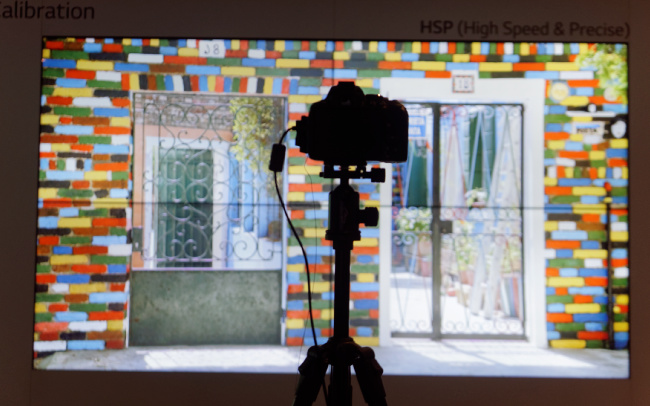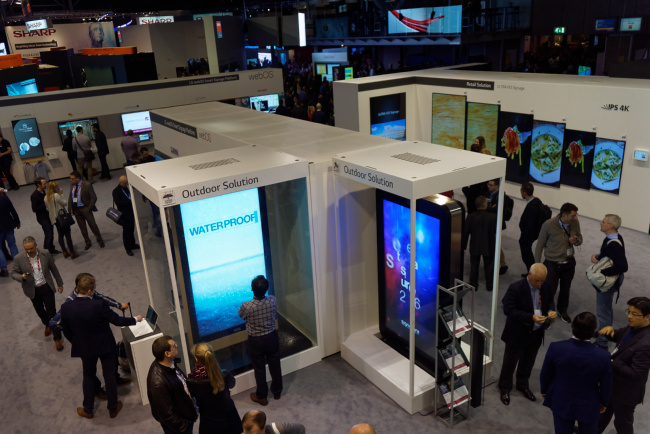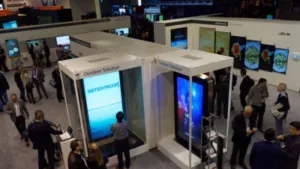Much of what was shown at ISE was previously shown in the LG Display meeting room at CES and that we have already reported on.
At the front of the booth were the double-sided curved OLEDs that were shown at CES. The OLEDs look very good, but brightness is not particularly high. The video wall using the 1.8mm (0.9mm + 0.9mm) narrow bezel monitors launched at Infocomm looked much better than at Gitex and Infocomm and LG is now able to calibrate the units to get reasonable uniformity. At the show, LG was showing its Supersign WB (White Balance) software which can be used with a digital SLR to quickly correct uniformity and the evenness of video wall displays in just a few minutes.

There were a number of demos of SuperSign software, including SuperSign W which is free and supports the WebOS for digital signage and SuperSign C which allows colour calibration and balancing using RS232 and LAN connections.
We looked at the 86″ “ultra stretch” display, shown since Gitex, which has 3840 x 600 resolution and we heard that the finished monitor is available now, with pricing around €6,500. There was a demonstration of the LG “Shine Out” bonding technology being used for “shop window displays”. Staff highlighted the feature that the LG logo can be removed from the bottom of its commercial displays these days.
UltraHD is going to be a push for LG this year and 49″, 55″, 65″, 75″ (a new size), 86″ (from 84″ at the end of 2016) and 98″ UltraHD monitors were being shown. LG hopes that sales of UltraHD will be “meaningful” in 2016 as the new products become available. The 75UH5C is a 500 cd/m² LCD with 14.9mm bezels and UltraHD resolution. It can accept four FullHD inputs (via 3 HDMI inputs and one DisplayPort). It has WebOS and an SoC. It has a kit to allow the connection of OPS modules and it also supports beacon functions.
An 86″ UltraHD unit was being shown in a touch configuration, with a 10 point infrared touch frame.
In outdoor applications, robustness is essential and LG sells fully cased displays that are created by its LG-MRI subsidiary in the US. Apparently, a London sign was recently hit by a bus and survived. We found this nice demo of an LG-MRI display being “impact tested”. (http://tinyurl.com/hrdsqoe) The displays have been sold to ClearChannel, Signature and JCDecaux, among others.

LG’s “Smart” digital signage is based on the WebOS and is now in version 2, with version 3 coming soon. The company has been working on getting its menu systems for its TVs (consumer and commercial) and digital signage to basically operate in similar ways to make it easier for those that are familiar with its TVs. One of the features that staff highlighted to us is that the latest WebOS can support HEVC content and can support PC-less video sync.
LG told us that the Arm-architecture SoCs used on its digital signage displays is basically the same generation as the chips used in its current TVs. LG believes that it has caught up a lot with Samsung, which was ahead in getting support from third party signage software vendors. LG now has OneLan, SignageLive, Adgen and other packages supporting WebOS. In contrast to other companies offering systems with CPUs, LG seems quite low key in promoting which CPUs it uses. Staff said they thought it might be “A7” Arm and the website just says “quad core”.
While Samsung had a touch-enabled fridge at CES, LGE at ISE had a commercial “hybrid cooler” that is a fridge with an integrated LCD display that includes a presence sensor that can detect a user moving close to the door so that content can be modified. The fridge supports WebOS for use with cloud and other software, or can play back media from USB.
There was a 1.5mm LED wall being shown and LG said again that it is committed to entering the small pitch LED wall market in the future.
Finally, we had a look at some of LG’s OLED-based hospitality TVs which are going into high end hotels. LG has now put its Procentric software into its hospitality TVs, allowing operation that does not need a dedicated server. The company has also seen some demand for mirror displays from hotel operations and a 49″ version with 300 nits of output and rated for 24/7 operation was on show.
Analyst Comment
I said after CES that I was disappointed that I had not seen the “0.9mm” bezel video wall panel at CES that LG had been boasting about. I had been surprised that it showed something new after launching new video wall monitors at Infocomm last year. Then I realised, all that LG has done is to start talking about one bezel – the 0.9mm video wall is what they launched at Infocomm as 1.8mm! Of course, this is probably a reaction to Samsung showing a 1.4mm (0.9mm/0.5mm). I’m disappointed that I fell for LG’s trick, but it is in line with the generally poor understanding of marketing in the Western world that LG has demonstrated in recent years.
Although there was much emphasis on OLED at the show, I would be nervous about image burn in on digital signage applications and also the level of brightness that will be available using OLEDs. I can see the curved displays gaining some high prestige and fashion-based installations, where a relatively short life may not be an issue, but I still see OLED in digital signage as “noise, not signal”. (BR)

